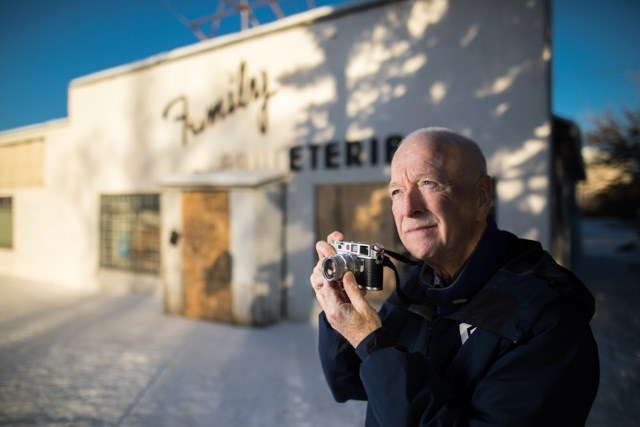Diminishing icons scattered across the prairies, representing a culture half a century old, often get little more than a glimpse from a passersby.
These fading and dilapidated motels, drive-ins, gas stations, general stores, car washes and advertisements were the inspiration behind Calgary documentary photographer George Webber’s exhibition, Simply Put: Vernacular Alberta.
“As a kid, this is just part of what I would see every day,” he said. “With the passage of time, these things that were one time part of your daily norm. Now you start to notice one thing is missing and then another and another.”
Through his lens, 65-year-old Webber captured abandoned buildings and decrepit signs from 1979 to 2012 that mark the prairie’s aging architecture.
“These things were mainstream culture and now they moved into the realm of the artifact,” he said. “I think that’s inevitable. Even some of the wonderful dramatic buildings in downtown Calgary, many of those are going to be gone in 50 years.”
About 35 of those images will be on display at the Okotoks Art Gallery’s large gallery Feb. 18 to April 1. It is part of Exposure, Alberta’s Photography Festival, featuring 40 exhibitions across the province.
“There’s something really quite revealing about the things that are just part of the normal parts of our culture,” he said. “When I look at them I look at these often small independently-run businesses. Many of these things endured for years, sometimes decades, so they speak of a certain continuity.”
The photographs represent a lifestyle and culture that’s very different from today, Webber said.
“These structures and the businesses and the drive-in theatre and the gas station, they were all essentially new cutting-edge innovative ways of dealing with the suddenly very much more mobile population that became the norm,” he said. “If you’re driving through Medicine Hat, for instance, there’s that wonderful stretch where you see all of these vintage motel signs from the ’50s and ’60s. A lot of these things came into existence when regular folks started to drive.”
These little bits and pieces of history scattered throughout the prairies tell a commercial story of small-town Alberta, said Webber.
“It’s a pretty fundamental impulse that people like myself that do documentary photography have a particular affection and interest in things that are part of your own history,” he said. “Especially as you get older and you see these things disappearing it sort of torques you up to capture these things because there’s a chance it’s going to vanish tomorrow. Virtually every man-made object will pass from being this phenomenally exciting new thing to transforming into an artifact into another bygone era. That’s inevitable.”
During his travels through the prairies, Webber noticed that the disposability of these structures and signs are accelerating. He said photographs such as his, which are printed on high-quality archival museum paper, will be one of the only things remaining of this era.
“It will be fascinating in 100 year or 200 years - everything that’s in the pictures will be gone,” he said. “It’s almost like an archeologist looking back on little clues and fragments of information. You could piece together a pretty rich story of civilization on these photographs left behind.”
Among the eye-catching components of Simply Put: Vernacular Alberta is the colour pallets popular in the ’50s and ’60s for advertising and promotion of businesses, said Webber.
“A younger person is likely to look at this work and be taken by the design, colour and sometimes improbable juxtaposition of things,” he said. “An older person is likely to first engage through memory in terms of seeing something that will trigger a memory or remind someone of an episode or incident in their own lives.”
Webber has been taking documentary photography in western Canada for about 40 years, spending time on First Nations reservations, Hutterite colonies and small towns that have since become ghost towns.
“I have a great affection for these places that I photographed,” he said. “People contact me with exhibition spaces and they say, ‘Do you have something?’ My answer is always ‘yes.’ I like the fact that because I’m not really planning for a book or exhibition these things can naturally and organically come into existence.”
To capture the images, Webber first began working with Kodachrome film, known for its exceptionally rich colour and high clarity, and in the past decade has worked with digital.
The Okotoks Art Gallery is open Tuesday to Saturdays from 10 a.m. to 5 p.m.
An opening reception will take place Feb. 18 at 1 p.m.




